自动化专业英语_考试版的文章翻译
- 格式:doc
- 大小:71.00 KB
- 文档页数:8
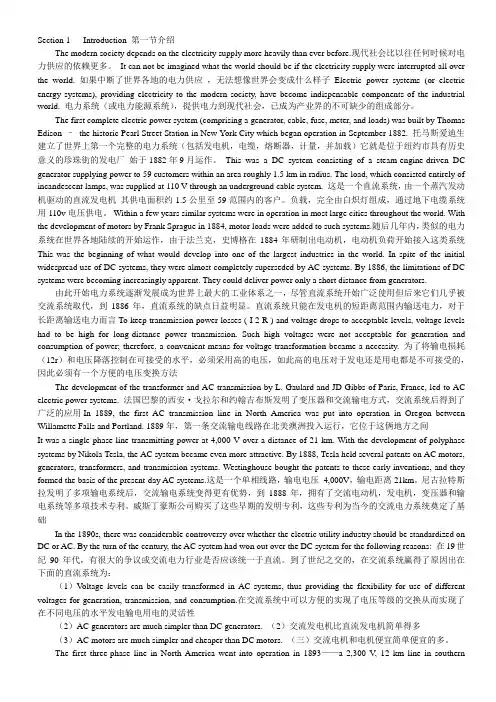
Section 1 Introduction 第一节介绍The modern society depends on the electricity supply more heavily than ever before.现代社会比以往任何时候对电力供应的依赖更多。
It can not be imagined what the world should be if the electricity supply were interrupted all over the world. 如果中断了世界各地的电力供应,无法想像世界会变成什么样子Electric power systems (or electric energy systems), providing electricity to the modern society, have become indispensable components of the industrial world. 电力系统(或电力能源系统),提供电力到现代社会,已成为产业界的不可缺少的组成部分。
The first complete electric power system (comprising a generator, cable, fuse, meter, and loads) was built by Thomas Edison –the historic Pearl Street Station in New York City which began operation in September 1882. 托马斯爱迪生建立了世界上第一个完整的电力系统(包括发电机,电缆,熔断器,计量,并加载)它就是位于纽约市具有历史意义的珍珠街的发电厂始于1882年9月运作。
This was a DC system consisting of a steam-engine-driven DC generator supplying power to 59 customers within an area roughly 1.5 km in radius. The load, which consisted entirely of incandescent lamps, was supplied at 110 V through an underground cable system. 这是一个直流系统,由一个蒸汽发动机驱动的直流发电机其供电面积约1.5公里至59范围内的客户。
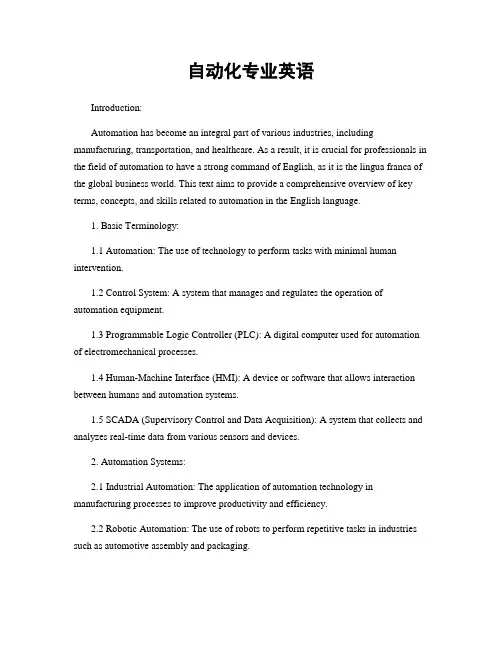
自动化专业英语Introduction:Automation has become an integral part of various industries, including manufacturing, transportation, and healthcare. As a result, it is crucial for professionals in the field of automation to have a strong command of English, as it is the lingua franca of the global business world. This text aims to provide a comprehensive overview of key terms, concepts, and skills related to automation in the English language.1. Basic Terminology:1.1 Automation: The use of technology to perform tasks with minimal human intervention.1.2 Control System: A system that manages and regulates the operation of automation equipment.1.3 Programmable Logic Controller (PLC): A digital computer used for automation of electromechanical processes.1.4 Human-Machine Interface (HMI): A device or software that allows interaction between humans and automation systems.1.5 SCADA (Supervisory Control and Data Acquisition): A system that collects and analyzes real-time data from various sensors and devices.2. Automation Systems:2.1 Industrial Automation: The application of automation technology in manufacturing processes to improve productivity and efficiency.2.2 Robotic Automation: The use of robots to perform repetitive tasks in industries such as automotive assembly and packaging.2.3 Process Automation: The automation of chemical, oil, and gas processes to enhance safety and accuracy.2.4 Home Automation: The integration of technology to control and monitor household devices and systems.3. Automation Techniques:3.1 Sensor Technology: Devices that detect and measure physical quantities such as temperature, pressure, and proximity.3.2 Actuators: Devices that convert electrical signals into mechanical motion, such as motors and solenoids.3.3 Feedback Control: A control technique that uses sensors to measure the output ofa system and adjust it accordingly.3.4 Artificial Intelligence (AI): The simulation of human intelligence in machines to perform tasks autonomously.3.5 Machine Learning: A subset of AI that enables machines to learn from data and improve their performance without explicit programming.4. Industrial Applications:4.1 Automotive Industry: Automation is extensively used in car manufacturing, including assembly line robots and quality control systems.4.2 Pharmaceutical Industry: Automation ensures precise dosage and packaging in pharmaceutical production.4.3 Food and Beverage Industry: Automation optimizes food processing, packaging, and quality control processes.4.4 Energy Sector: Automation is crucial in power plant operations, grid management, and renewable energy systems.4.5 Healthcare Industry: Automation is utilized in medical imaging, patient monitoring, and laboratory analysis.5. Skills for Automation Professionals:5.1 Programming: Proficiency in programming languages such as C++, Python, and ladder logic for PLC programming.5.2 Data Analysis: Ability to analyze and interpret data collected from automation systems using statistical methods and software tools.5.3 Troubleshooting: Expertise in identifying and resolving issues in automation systems, including hardware and software components.5.4 Project Management: Skills to plan, execute, and monitor automation projects, ensuring timely completion and adherence to budget.5.5 Communication: Effective communication skills to collaborate with cross-functional teams and articulate technical concepts to non-technical stakeholders.Conclusion:Automation plays a pivotal role in today's industries, and proficiency in English is essential for professionals in the field. This text has provided a comprehensive overview of key terms, concepts, and skills related to automation in the English language. By mastering these aspects, automation professionals can enhance their communication, expand their knowledge, and contribute to the advancement of automation technology.。
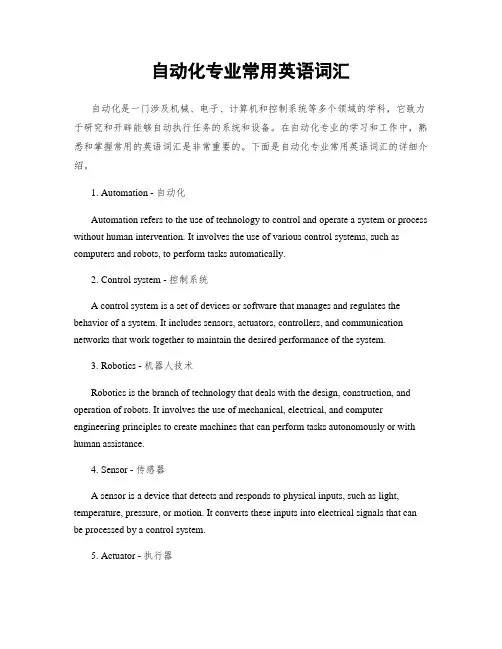
自动化专业常用英语词汇自动化是一门涉及机械、电子、计算机和控制系统等多个领域的学科,它致力于研究和开辟能够自动执行任务的系统和设备。
在自动化专业的学习和工作中,熟悉和掌握常用的英语词汇是非常重要的。
下面是自动化专业常用英语词汇的详细介绍。
1. Automation - 自动化Automation refers to the use of technology to control and operate a system or process without human intervention. It involves the use of various control systems, such as computers and robots, to perform tasks automatically.2. Control system - 控制系统A control system is a set of devices or software that manages and regulates the behavior of a system. It includes sensors, actuators, controllers, and communication networks that work together to maintain the desired performance of the system.3. Robotics - 机器人技术Robotics is the branch of technology that deals with the design, construction, and operation of robots. It involves the use of mechanical, electrical, and computer engineering principles to create machines that can perform tasks autonomously or with human assistance.4. Sensor - 传感器A sensor is a device that detects and responds to physical inputs, such as light, temperature, pressure, or motion. It converts these inputs into electrical signals that can be processed by a control system.5. Actuator - 执行器An actuator is a device that converts electrical, hydraulic, or pneumatic energy into mechanical motion. It is used to control or move a mechanism or system, such as opening or closing a valve or moving a robotic arm.6. Programmable Logic Controller (PLC) - 可编程逻辑控制器A programmable logic controller (PLC) is a specialized computer used to control and automate industrial processes. It is programmable and can be easily reconfigured to adapt to different tasks or requirements.7. Human-Machine Interface (HMI) - 人机界面The human-machine interface (HMI) is the user interface through which an operator interacts with a control system. It typically consists of a graphical display, buttons, and other input/output devices that allow the operator to monitor and control the system.8. Supervisory Control and Data Acquisition (SCADA) - 监控与数据采集系统Supervisory Control and Data Acquisition (SCADA) is a system used to monitor and control industrial processes. It collects real-time data from various sensors and devices and provides a graphical interface for operators to monitor and control the system.9. Industrial Internet of Things (IIoT) - 工业物联网The Industrial Internet of Things (IIoT) refers to the use of internet-connected devices and sensors in industrial settings to collect and exchange data. It enables real-time monitoring, analysis, and control of industrial processes, leading to improved efficiency and productivity.10. Machine Learning - 机器学习Machine learning is a subset of artificial intelligence that focuses on the development of algorithms and models that allow computers to learn and make predictions or decisions without being explicitly programmed. It is widely used in automation to improve system performance and decision-making.11. Control loop - 控制回路A control loop is a closed-loop system that continuously monitors and adjusts the output of a process to maintain a desired setpoint. It typically consists of a sensor, controller, and actuator that work together to regulate the system.12. Feedback - 反馈Feedback is the process of returning a portion of the output of a system back to the input for comparison and adjustment. It is used in control systems to continuously monitor and correct deviations from the desired performance.13. PID controller - 比例-积分-微分控制器A PID controller is a type of control algorithm that uses proportional, integral, and derivative actions to control a system. It is widely used in automation to achieve accurate and stable control of processes.14. Fault diagnosis - 故障诊断Fault diagnosis is the process of identifying and diagnosing faults or malfunctions in a system. It involves analyzing sensor data, system behavior, and performance to determine the cause of the problem and take appropriate corrective actions.15. Safety system - 安全系统A safety system is a set of measures and devices designed to prevent accidents and ensure the safety of personnel and equipment. It includes emergency stop buttons, safety interlocks, and protective barriers to minimize the risk of injury or damage.以上是自动化专业常用英语词汇的详细介绍。
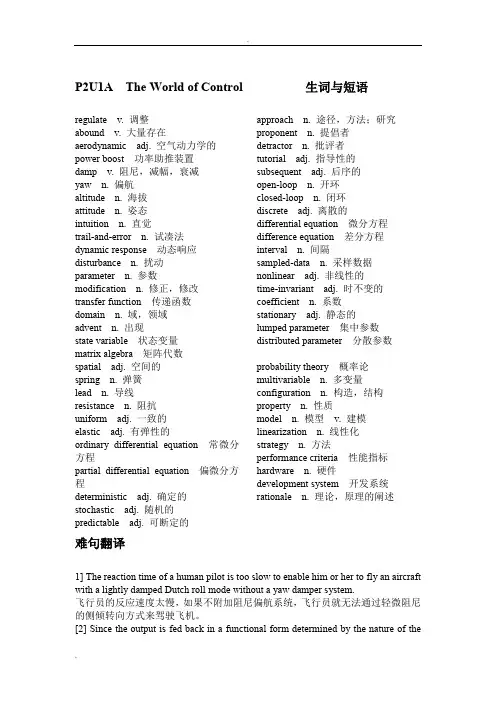
P2U1A The World of Control 生词与短语regulate v. 调整abound v. 大量存在aerodynamic adj. 空气动力学的power boost 功率助推装置damp v. 阻尼,减幅,衰减yaw n. 偏航altitude n. 海拔attitude n. 姿态intuition n. 直觉trail-and-error n. 试凑法dynamic response 动态响应disturbance n. 扰动parameter n. 参数modification n. 修正,修改transfer function 传递函数domain n. 域,领域advent n. 出现state variable 状态变量matrix algebra 矩阵代数approach n. 途径,方法;研究proponent n. 提倡者detractor n. 批评者tutorial adj. 指导性的subsequent adj. 后序的open-loop n. 开环closed-loop n. 闭环discrete adj. 离散的differential equation 微分方程difference equation 差分方程interval n. 间隔sampled-data n. 采样数据nonlinear adj. 非线性的time-invariant adj. 时不变的coefficient n. 系数stationary adj. 静态的lumped parameter 集中参数distributed parameter 分散参数spatial adj. 空间的spring n. 弹簧lead n. 导线resistance n. 阻抗uniform adj. 一致的elastic adj. 有弹性的ordinary differential equation 常微分方程partial differential equation 偏微分方程deterministic adj. 确定的stochastic adj. 随机的predictable adj. 可断定的probability theory 概率论multivariable n. 多变量configuration n. 构造,结构property n. 性质model n. 模型v. 建模linearization n. 线性化strategy n. 方法performance criteria 性能指标hardware n. 硬件development system 开发系统rationale n. 理论,原理的阐述难句翻译1] The reaction time of a human pilot is too slow to enable him or her to fly an aircraft with a lightly damped Dutch roll mode without a yaw damper system.飞行员的反应速度太慢,如果不附加阻尼偏航系统,飞行员就无法通过轻微阻尼的侧倾转向方式来驾驶飞机。
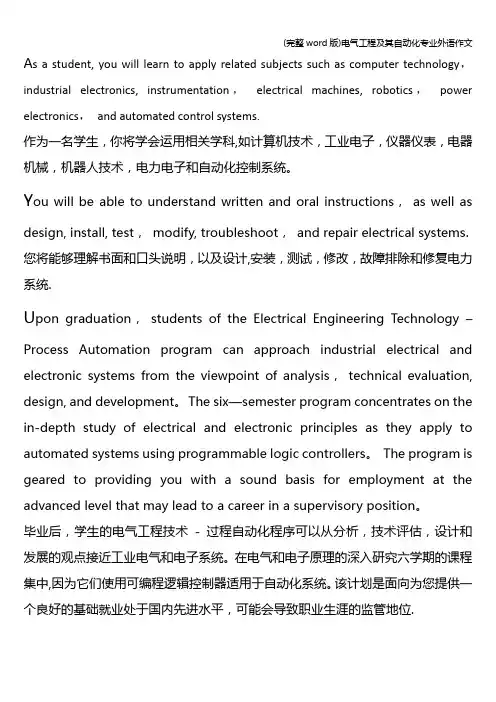
(完整word版)电气工程及其自动化专业外语作文A s a student, you will learn to apply related subjects such as computer technology,industrial electronics, instrumentation,electrical machines, robotics,power electronics,and automated control systems.作为一名学生,你将学会运用相关学科,如计算机技术,工业电子,仪器仪表,电器机械,机器人技术,电力电子和自动化控制系统。
Y ou will be able to understand written and oral instructions,as well as design, install, test,modify, troubleshoot,and repair electrical systems.您将能够理解书面和口头说明,以及设计,安装,测试,修改,故障排除和修复电力系统.U pon graduation,students of the Electrical Engineering Technology –Process Automation program can approach industrial electrical and electronic systems from the viewpoint of analysis,technical evaluation, design, and development。
The six—semester program concentrates on the in-depth study of electrical and electronic principles as they apply to automated systems using programmable logic controllers。

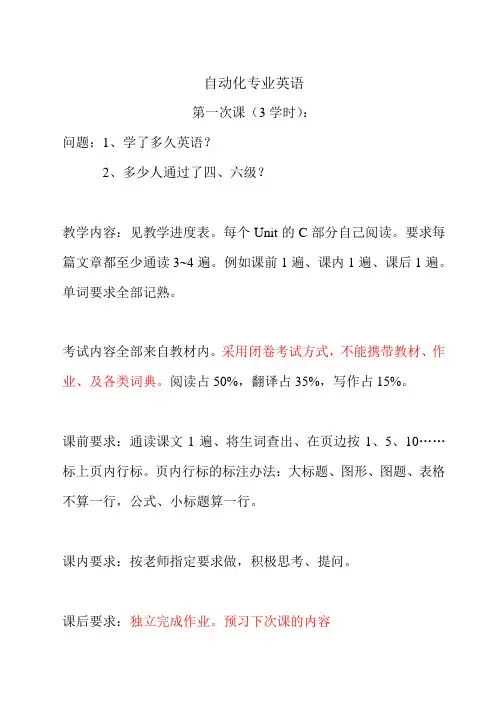
自动化专业英语第一次课(3学时):问题:1、学了多久英语?2、多少人通过了四、六级?教学内容:见教学进度表。
每个Unit的C部分自己阅读。
要求每篇文章都至少通读3~4遍。
例如课前1遍、课内1遍、课后1遍。
单词要求全部记熟。
考试内容全部来自教材内。
采用闭卷考试方式,不能携带教材、作业、及各类词典。
阅读占50%,翻译占35%,写作占15%。
课前要求:通读课文1遍、将生词查出、在页边按1、5、10……标上页内行标。
页内行标的标注办法:大标题、图形、图题、表格不算一行,公式、小标题算一行。
课内要求:按老师指定要求做,积极思考、提问。
课后要求:独立完成作业。
预习下次课的内容成绩计算办法:平时成绩30%,期终考试成绩70%。
平时成绩由作业决定,缺交作业、或者作业抄袭者(包括将作业给别人抄袭者)记为0分。
作业不整洁者最多得10分。
作业必须按时完成,必须在上课前交作业!!迟到者不收!请假者,请通过他人交作业。
养成良好的阅读习惯。
阅读是一种重要的技能,良好的阅读习惯是可以培养的。
几种阅读方法:Skimming:浏览或者略读。
只需要理解文章内容的大约50%,快速地获取中心意思和重点。
速度为300~1000WPM。
关键是掌握英文的写作特点。
将重点放在句首和句尾的主题句上。
注意抓住关键词。
Scanning:浏览或者查阅。
查阅只需要从文章中有目的地迅速查找某一具体事实或者特定信息。
Fast reading:快速阅读。
速度为200~350 wpm。
要求基本上理解文章内容。
为了养成快速阅读的习惯,注意在阅读时不要发出声音;不要用铅笔、手指等在文字下移动;不要在自己不懂的单词旁标注中文;不要中断阅读去查生词;不要逐字逐字地读。
要从逐字逐字地读逐步改为按意群来读。
精读:在阅读的同时对文章从各方面(包括语法、词汇、写作特点和中心思想)进行分析。
要注意培养自己的中文阅读能力。
要丰富自己的知识结构。
要提高自己的词汇量。
而所有这一切又都是要在阅读实践中来完成的。
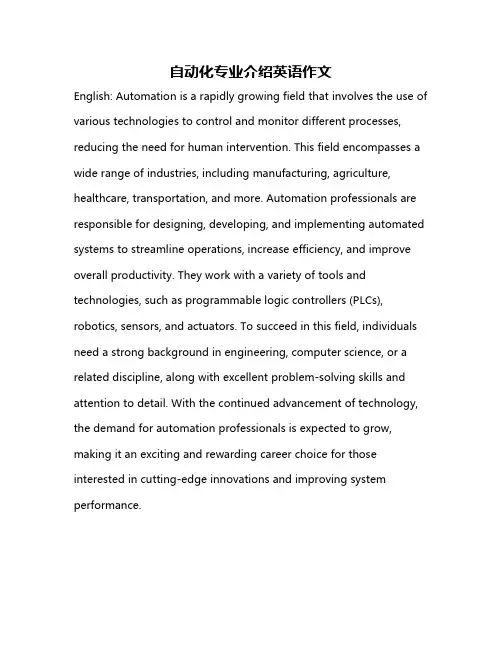
自动化专业介绍英语作文English: Automation is a rapidly growing field that involves the use of various technologies to control and monitor different processes, reducing the need for human intervention. This field encompasses a wide range of industries, including manufacturing, agriculture, healthcare, transportation, and more. Automation professionals are responsible for designing, developing, and implementing automated systems to streamline operations, increase efficiency, and improve overall productivity. They work with a variety of tools and technologies, such as programmable logic controllers (PLCs), robotics, sensors, and actuators. To succeed in this field, individuals need a strong background in engineering, computer science, or a related discipline, along with excellent problem-solving skills and attention to detail. With the continued advancement of technology, the demand for automation professionals is expected to grow, making it an exciting and rewarding career choice for those interested in cutting-edge innovations and improving system performance.中文翻译: 自动化是一个快速发展的领域,涉及使用各种技术来控制和监控不同的流程,减少人为干预的需求。

第一段翻译(2):what is the exact valueo f the number pai?a mathematici an made an experi mentin orderto find his own estima tionof the number pai.in his experi ment,he used an old bicycl e wheelof diamet er 63.7cm.he marked the pointon the tire wherethe wheelwas touchi ng the ground and he rolled the wheelstraig ht aheadby turnin g it 20 times.next,he measur ed the distan ce travel ed by the wheel,whichwas 39.69 meters.he divide d the number3969 by 20*63.7 and obtain ed 3.115384615 as an approx imati on of the number pai.of course,this was just his estima te of the number pai and he was awarethat it was not very accura te.数π的精确值是什么?一位数学家做了实验以便找到他自己对数π的估计。
在试验中,他用了一直径63.1厘米的旧自行车轮。
他在车轮接触地面的轮胎上做了标记,而且将车轮向前转动20次。
接下来,他测量了车轮经过的距离,是39.69米。
他用3969除20*63.7得到了数π的近似值3.115384615。
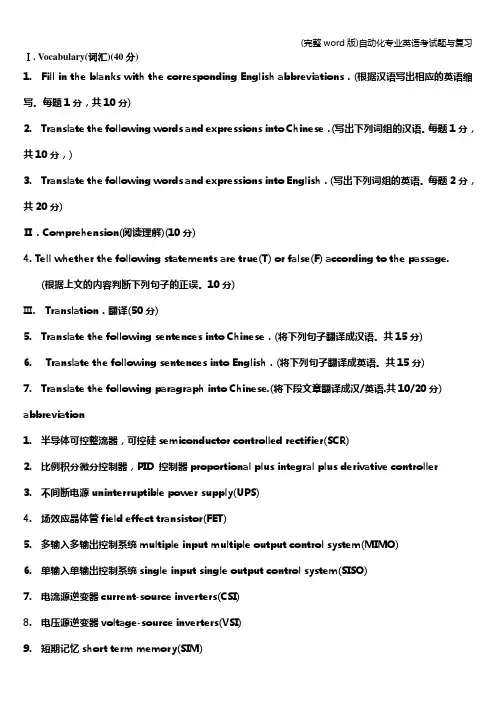
Ⅰ. Vocabulary(词汇)(40分)1. Fill in the blanks with the corresponding English abbreviations.(根据汉语写出相应的英语缩写。
每题1分,共10分)2. Translate the following words and expressions into Chinese.(写出下列词组的汉语。
每题1分,共10分,)3. Translate the following words and expressions into English.(写出下列词组的英语。
每题2分,共20分)Ⅱ.Comprehension(阅读理解)(10分)4. Tell whether the following statements are true(T) or false(F) according to the passage.(根据上文的内容判断下列句子的正误。
10分)Ⅲ. Translation.翻译(50分)5. Translate the following sentences into Chinese.(将下列句子翻译成汉语。
共15分)6. Translate the following sentences into English.(将下列句子翻译成英语。
共15分)7. Translate the following paragraph into Chinese.(将下段文章翻译成汉/英语.共10/20分) abbreviation1. 半导体可控整流器,可控硅semiconductor controlled rectifier(SCR)2. 比例积分微分控制器,PID 控制器proportional plus integral plus derivative controller3. 不间断电源uninterruptible power supply(UPS)4. 场效应晶体管field effect transistor(FET)5. 多输入多输出控制系统multiple input multiple output control system(MIMO)6. 单输入单输出控制系统single input single output control system(SISO)7. 电流源逆变器current-source inverters(CSI)8. 电压源逆变器voltage-source inverters(VSI)9. 短期记忆short term memory(SIM)10. 方法库way base(WB)11. 方法库管理系统way base management system (WBMS)12. 光符阅读机(OCR)optical character reader13. 集成电路芯片IC(integrated circuit) chip14. 交流电alternating current(AC)15. 可编程控制PLC(Programmable Logic Controller)16. 脉宽调制pluse-width modulation (PWM)17. 气关式air-to-close(AC)18. 气开式air-to-open(AO)19. 人工智能artificial intelligence(AI)20. 直接数字控制,direct digital control (DDC)21. 运算放大器operational Amplifier (OA)Vocabulary-11. Automatic control 自动控制2. Dynamic system 动态系统3. Differential equation 微分方程4. Frequency response methods 频率响应方法5. Root-locus methods 根轨迹的方法6. Feedback control system 反馈控制系统7. Optimal control 最优控制Vocabulary-21. Forcing function2. Mathematical model3. First-order differential equation4. Transient- response analysis5. Frequency- response analysis6. Ordinary differential equation7. Partial differential equation8. The principle of superposition9. Linear time-invariant /time-varying system10. Nonlinear systemVocabulary-31. Control action2. Two-position or on off controllers3. Actuating error signal4. Closed-loop system5. Reference input signal6. Self-operated controllers7. Set point8. Flow rate9. Actuating element10. Differential gapVocabulary-41. Laplace transform2. rate control 速率控制,微分控制3. Reset rate 复位率4. transient period 过渡周期5. feedback path 反馈通道6. second-order 二阶的7. block diagram 方块图8. load disturbance 负荷(负载)扰动9. negative feedback 负反馈10. Fundamental principle 基本原则Vocabulary-51. scompensation technique 补偿技术、校正方法2. Performance specification 性能规范3. time-domain performance measures 时域性能指标4. Rise/settling time 上升/调整时间5. phase/ gain margin相位/增益裕度6. trial-and-error approach 逐次逼近法7. Adjust parameter setting 调整参数设置8. steady-state behavior 稳态特性9. series compensation and feedback(or parallel) compensation串联校正和反馈(并联)校正10. lag-lead compensator 滞后/超前校正装置基于GPS/GPRS 的公交车自动报站系统设计•摘要:结合GPS定位,对车辆的状态信息(位置、速度等)进行实时采集及分析,当车辆到达预定位置时,实现公交车的自动报站功能;通过GPRS网络,将公交车的状态信息及时传输到公交监控调度中心,然后通过中心上位机软件的操作,实现对公交车的监控调度、信息更新的功能.采用SD卡存储多条线路信息及MP3语音文件,便于公交车更换公交线路,同时实现高品质语音信息的播放.•关键词:自动报站;GPS;GPRS;信息更新;监控调度•Design of GPS/GPRS bus stop automatic announcerDesign of Automatic Station Report System for Bus Based on GPS/•Abstract: Combining GPS positioning technology, the bus status (information location, speed, etc.) in real-time are collected and analyzed. When the bus is scheduled to arrive at the location, the automatic station report functions is realized. Through the GPRS network, necessary bus status information should be transmitted to the bus monitor dispatching center timely, and then through the center of the operation of PC software, to achieve the function of the monitoring, scheduling and updating information. SD card is used to memorize the information of a number of lines and MP3 audio files, it is facilitated to replace bus lines , and at the same time high-quality voice information play is realized. •Keywords: automatic station report; GPS; GPRS; information updating; monitoring; dispatching基于μPD78F0034单片机的出租车计费器的设计与实现•摘要:介绍了基于μPD78F0034单片机和模块式结构的出租车计费器的软件和硬件设计方法,讨论了μPD78F0034单片机的主要特点;介绍了该单片机和PC机串行通信的硬件连接方法;同时给出了采用单双信号防作弊技术来防止计费器作弊的具体实现方法。
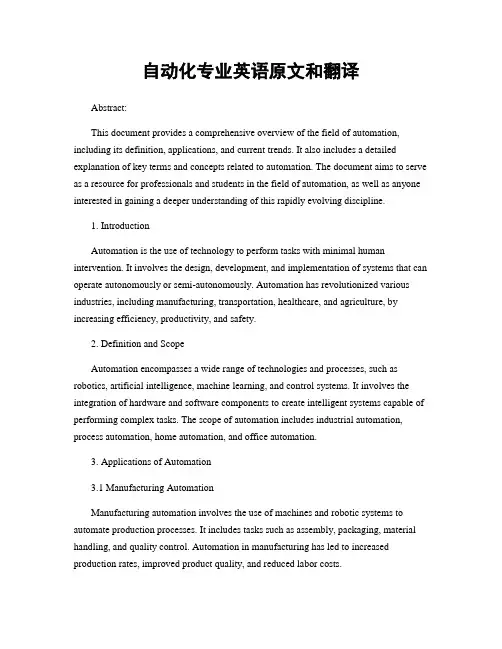
自动化专业英语原文和翻译Abstract:This document provides a comprehensive overview of the field of automation, including its definition, applications, and current trends. It also includes a detailed explanation of key terms and concepts related to automation. The document aims to serve as a resource for professionals and students in the field of automation, as well as anyone interested in gaining a deeper understanding of this rapidly evolving discipline.1. IntroductionAutomation is the use of technology to perform tasks with minimal human intervention. It involves the design, development, and implementation of systems that can operate autonomously or semi-autonomously. Automation has revolutionized various industries, including manufacturing, transportation, healthcare, and agriculture, by increasing efficiency, productivity, and safety.2. Definition and ScopeAutomation encompasses a wide range of technologies and processes, such as robotics, artificial intelligence, machine learning, and control systems. It involves the integration of hardware and software components to create intelligent systems capable of performing complex tasks. The scope of automation includes industrial automation, process automation, home automation, and office automation.3. Applications of Automation3.1 Manufacturing AutomationManufacturing automation involves the use of machines and robotic systems to automate production processes. It includes tasks such as assembly, packaging, material handling, and quality control. Automation in manufacturing has led to increased production rates, improved product quality, and reduced labor costs.3.2 Transportation AutomationTransportation automation aims to automate various aspects of transportation systems, including vehicles, traffic control, and logistics. It includes technologies such as autonomous vehicles, intelligent transportation systems, and automated warehouses. Automation in transportation can enhance safety, reduce congestion, and optimize resource utilization.3.3 Healthcare AutomationHealthcare automation involves the use of technology to streamline healthcare processes and improve patient care. It includes electronic medical records, telemedicine, robotic surgery, and automated drug dispensing systems. Automation in healthcare can enhance accuracy, reduce errors, and improve overall efficiency.3.4 Agriculture AutomationAgriculture automation focuses on automating agricultural processes to increase productivity and reduce labor requirements. It includes technologies such as precision farming, automated irrigation systems, and robotic harvesting. Automation in agriculture can optimize resource usage, improve crop yields, and minimize environmental impact.4. Key Terms and Concepts4.1 RoboticsRobotics is the branch of automation that deals with the design, construction, and operation of robots. Robots are programmable machines capable of carrying out tasks autonomously or under human supervision. They can be used in various industries for tasks that are dangerous, repetitive, or require high precision.4.2 Artificial Intelligence (AI)Artificial Intelligence refers to the ability of machines to mimic human intelligence and perform tasks that typically require human intelligence, such as speech recognition,decision-making, and problem-solving. AI is a key component of many automation systems, enabling machines to learn from data and adapt to changing conditions.4.3 Machine LearningMachine Learning is a subset of AI that focuses on the development of algorithms and models that allow machines to learn from data and make predictions or decisions without explicit programming. Machine learning algorithms are used in various automation applications, such as image recognition, natural language processing, and predictive maintenance.4.4 Control SystemsControl systems are used to monitor and regulate the behavior of machines and processes. They involve sensors, actuators, and feedback mechanisms to maintain desired performance and stability. Control systems are essential in automation to ensure accurate and reliable operation of automated systems.5. Current Trends in Automation5.1 Internet of Things (IoT)The Internet of Things refers to the network of interconnected devices that can communicate and exchange data. IoT enables automation by connecting physical objects to the internet, allowing remote monitoring and control. It has applications in various domains, such as smart homes, industrial automation, and healthcare.5.2 Big Data AnalyticsBig Data Analytics involves the use of advanced analytics techniques to extract insights from large and complex datasets. In automation, big data analytics can be used to optimize processes, detect anomalies, and make data-driven decisions. It enables predictive maintenance, real-time monitoring, and continuous improvement.5.3 Collaborative RobotsCollaborative robots, also known as cobots, are designed to work alongside humans in a shared workspace. They are equipped with sensors and safety features to ensure safe interaction with humans. Collaborative robots are increasingly used in manufacturing, healthcare, and other industries to enhance productivity and flexibility.Conclusion:Automation is a rapidly evolving field with significant implications for various industries and society as a whole. This document has provided an in-depth overview of automation, including its definition, applications, key terms, and current trends. It serves as a valuable resource for professionals and students in the field of automation, as well as anyone interested in understanding the fundamental concepts and advancements in this exciting discipline.。
翻译P.1The voltage across a pure inductor is defined by Faraday’law,which states that the voltage across the inductor is proportional to the rate of change with time of the current through the inductor.thus we have U=Ldi/dt.纯电感电压由法拉第定律定义,法拉第定律指出:电感两头的电压正比于流过电感的电流随时间的变化率。
所以可获取:U=Ldi/dt式中di/dt = 电流变化率,安培/秒;L =感觉系数,享利。
P.3A three-phase electric circuit is energized by three alternating emfs of the same frequency and differing in time phase by 120 electrical degrees .三相电压的产生三相电路可由三个频次同样在时间相位上相差120°电角度的电动势供电。
P.9One problem with electronic devices corresponding to the generalized amplifiers is that the gains,AU or AI ,depend upon internal properties of two-port system( ).This makes design difficult since these parameters usually vary from device to device ,as well as temperature .运算放大器像广义放大器这样的电子器件存在的一个问题就是它们的增益 AU 或 AI 取决于双端口系统 (m、b、RI、Ro 等)的内部特征。
自动化专业英语原文和翻译英文原文:Automation is the technology by which a process or procedure is performed with minimal human assistance. Automation or automatic control is the use of various control systems for operating equipment such as machinery, processes in factories, boilers, and heat treating ovens, switching on telephone networks, steering, and stabilization of ships, aircraft, and other applications and vehicles with minimal or reduced human intervention. Some processes have been completely automated.自动化是一种通过至少的人力辅助来执行过程或者程序的技术。
自动化或者自动控制是使用各种控制系统来操作设备,例如机械、工厂中的工艺流程、锅炉和热处理炉、电话网络的开关、船舶、飞机和其他应用和车辆的控制和稳定,从而实现最小化或者减少人类干预。
一些过程已经彻底自动化。
Automation plays a crucial role in various industries and sectors, including manufacturing, transportation, healthcare, and many others. It involves the use of advanced technologies and control systems to streamline processes, improve efficiency, and reduce human error.In the manufacturing industry, automation is used extensively to carry out repetitive tasks, such as assembly line operations. This not only speeds up production but also ensures consistent quality and reduces the risk of accidents. Robots and robotic systems are commonly employed in manufacturing plants to handle tasks that are dangerous or require high precision.在创造业中,自动化被广泛应用于执行重复性任务,例如流水线操作。
电气自动化的英文作文高中英文:Electric automation is a field that I am very passionate about. It involves the use of electrical control systems to automate processes and machinery, which can greatly improve efficiency and productivity in various industries. One of the most common examples of electric automation is in manufacturing, where machines are used to perform repetitive tasks with precision and speed.For example, in a car manufacturing plant, robots are used to assemble parts and perform welding tasks, which not only speeds up the production process but also ensures consistent quality. This level of automation would not be possible without the use of electrical control systems to monitor and regulate the machines' movements and functions.In addition to manufacturing, electric automation is also widely used in the energy sector. Power plants rely onsophisticated control systems to regulate the generation and distribution of electricity, ensuring a stable and reliable power supply to consumers. Without these automated systems, the process of generating and distributing electricity would be much more labor-intensive and prone to human error.Furthermore, electric automation plays a crucial rolein the field of transportation. Traffic lights, railway signaling systems, and automated guided vehicles are all examples of how electrical control systems are used to improve the safety and efficiency of transportation networks.Overall, electric automation has revolutionized the way we live and work, making processes faster, more accurate, and less reliant on human intervention. It has also created new job opportunities in the field of engineering and technology, as skilled professionals are needed to design, maintain, and troubleshoot these complex systems.中文:电气自动化是我非常热衷的领域。
电气自动化的英文作文高中英文:Electric automation is a crucial part of modernindustrial processes. It involves the use of variouscontrol systems to operate different types of equipment, such as machinery, processes in factories, boilers, andheat treating ovens. These control systems can range from simple on-off switches to complex computer-based systemsthat monitor and control entire production processes.One of the key benefits of electric automation is its ability to improve efficiency and productivity. For example, in a manufacturing plant, automated systems can perform repetitive tasks with precision and speed, reducing theneed for human intervention and minimizing the risk of errors. This not only increases the overall output but also ensures consistent quality of the products.Moreover, electric automation plays a vital role inenhancing safety in industrial environments. By automating hazardous tasks, such as handling of toxic chemicals or working in extreme temperatures, it reduces the exposure of workers to potential risks and hazards. This ultimately leads to a safer work environment and reduces the number of workplace accidents.In addition, electric automation also enables real-time monitoring and control of processes, allowing for quick adjustments and interventions when necessary. For instance, in a power plant, automated systems can continuously monitor the performance of turbines and generators and make immediate adjustments to optimize efficiency and prevent equipment failures.Furthermore, electric automation contributes to cost savings by reducing the consumption of energy and raw materials. Automated systems can regulate the usage of resources more efficiently, minimizing waste and lowering operational costs. This not only benefits the company's bottom line but also has positive environmental impacts by reducing the overall carbon footprint.In conclusion, electric automation is a critical component of modern industrial operations, offering numerous benefits such as improved efficiency, enhanced safety, real-time monitoring, and cost savings. Its widespread adoption continues to drive advancements in industrial processes, making them more reliable, productive, and sustainable.中文:电气自动化是现代工业过程中至关重要的一部分。
介绍自动化英文作文英文:Automation refers to the use of technology to perform tasks without human intervention. It has become an increasingly important aspect of modern society and has revolutionized many industries. Automation can be found in various forms, including robotic automation, process automation, and software automation.One of the benefits of automation is increased efficiency. Automated processes can perform tasks faster and more accurately than humans, leading to higher productivity and reduced costs. For example, in manufacturing, robots can assemble products at a much faster rate than humans, while also reducing the risk of errors.Another benefit of automation is improved safety. By taking humans out of dangerous or hazardous situations,automation can reduce the risk of accidents and injuries. For example, in the mining industry, automated machinery can be used to extract minerals from underground mines, reducing the risk of cave-ins and other accidents.However, automation also has its drawbacks. One of the main concerns is job displacement. As more tasks become automated, there is a risk that jobs will be lost, particularly in industries that rely heavily on manual labor. It is important to ensure that workers are trained for new roles and that there are opportunities for retraining and upskilling.Overall, automation has the potential to bring significant benefits to society, but it is important to consider the potential drawbacks and to ensure that the transition to automation is managed in a responsible way.中文:自动化是指使用技术来执行任务,无需人类干预。
UNIT 1A 电路电路或电网络由以某种方式连接的电阻器、电感器和电容器等元件组成。
如果网络不包含能源,如电池或发电机,那么就被称作无源网络。
换句话说,如果存在一个或多个能源,那么组合的结果为有源网络。
在研究电网络的特性时,我们感兴趣的是确定电路中的电压和电流。
因为网络由无源电路元件组成,所以必须首先定义这些元件的电特性.就电阻来说,电压-电流的关系由欧姆定律给出,欧姆定律指出:电阻两端的电压等于电阻上流过的电流乘以电阻值。
在数学上表达为: u=iR (1-1A-1)式中 u=电压,伏特;i =电流,安培;R = 电阻,欧姆。
纯电感电压由法拉第定律定义,法拉第定律指出:电感两端的电压正比于流过电感的电流随时间的变化率。
因此可得到:U=Ldi/dt 式中 di/dt = 电流变化率,安培/秒; L = 感应系数,享利。
电容两端建立的电压正比于电容两极板上积累的电荷q 。
因为电荷的积累可表示为电荷增量dq的和或积分,因此得到的等式为 u= ,式中电容量C是与电压和电荷相关的比例常数。
由定义可知,电流等于电荷随时间的变化率,可表示为i = dq/dt。
因此电荷增量dq 等于电流乘以相应的时间增量,或dq = i dt,那么等式 (1-1A-3) 可写为式中 C = 电容量,法拉。
归纳式(1-1A-1)、(1-1A-2) 和 (1-1A-4)描述的三种无源电路元件如图1-1A-1所示。
注意,图中电流的参考方向为惯用的参考方向,因此流过每一个元件的电流与电压降的方向一致。
有源电气元件涉及将其它能量转换为电能,例如,电池中的电能来自其储存的化学能,发电机的电能是旋转电枢机械能转换的结果。
有源电气元件存在两种基本形式:电压源和电流源。
其理想状态为:电压源两端的电压恒定,与从电压源中流出的电流无关。
因为负载变化时电压基本恒定,所以上述电池和发电机被认为是电压源。
另一方面,电流源产生电流,电流的大小与电源连接的负载无关。
虽然电流源在实际中不常见,但其概念的确在表示借助于等值电路的放大器件,比如晶体管中具有广泛应用。
电压源和电流源的符号表示如图1-1A-2所示。
分析电网络的一般方法是网孔分析法或回路分析法。
应用于此方法的基本定律是基尔霍夫第一定律,基尔霍夫第一定律指出:一个闭合回路中的电压代数和为0,换句话说,任一闭合回路中的电压升等于电压降。
网孔分析指的是:假设有一个电流——即所谓的回路电流——流过电路中的每一个回路,求每一个回路电压降的代数和,并令其为零。
考虑图1-1A-3a 所示的电路,其由串联到电压源上的电感和电阻组成,假设回路电流i ,那么回路总的电压降为因为在假定的电流方向上,输入电压代表电压升的方向,所以输电压在(1-1A-5)式中为负。
因为电流方向是电压下降的方向,所以每一个无源元件的压降为正。
利用电阻和电感压降公式,可得等式(1-1A-6)是电路电流的微分方程式。
或许在电路中,人们感兴趣的变量是电感电压而不是电感电流。
正如图1-1A-1指出的用积分代替式(1-1A-6)中的i,可得1-1A-7UNIT 3A 逻辑变量与触发器逻辑变量我们讨论的双值变量通常叫做逻辑变量,而象或和与这样的操作被称为逻辑操作。
现在我们将简要地讨论一下这些术语之间的关联,并在此过程中,阐明用标示“真”和“假”来识别一个变量的可能值的特殊用途。
举例说明,假设你和两个飞行员在一架空中航行的飞机中,你在客舱中,而飞行员A和 B在驾驶员座舱中。
在某一时刻,A来到了你所在的客舱中,你并不担心这种变化。
然而,假设当你和A 在客舱时,你抬头发现B 也已经来到了你所在的客舱中。
基于你的逻辑推理能力,你将会推断飞机无人驾驶;并且,大概你已听到了警报,以致使驾驶员之一将迅速对此紧急情况作出响应。
换句话说,假设每一位飞行员座位下面有一个电子装置,当座位上有人时,其输出电压为V1,当座位上无人时,其输出电压为V2。
现在我们用“真”来代表电压V2,从而使电压V1表示“假”。
让我们进一步制作一个带有两个输入端和一个输出端的电路,此电路的特性是:只要两个输入,即一个输入同时和另一个输入相与,结果为V2时,输出电压才是V2。
否则,输出是V1。
最后,让我们把输入和飞行员A 和B 座位下的装置联结起来,并安装一个与输出Z相连的警铃,当输出是V2 (“真”)时响应,否则不响应。
这样,我们已创建了一个执行与操作的电路,这个电路能完成当两个驾驶员确实都离开驾驶舱时飞机是无人驾驶的逻辑推断。
概括一下,情形如下:符号A、B和Z 代表命题A =飞行员A已离开座位为真(T)B = 飞行员B已离开座位为真(T)Z = 飞机无人驾驶,处于危险状况时为真(T)当然,、和分别代表相反的命题。
例如,代表的命题是当飞行员离开驾驶舱等时为假(F),以此类推。
命题间的关系可写为 Z=AB (1-3A-1)我们已经选择用电压来表示逻辑变量A、 B和Z 。
但是必须注意,实际上式 (1-3A-1) 是命题间的关系,与我们选择的表示命题的确切方式无关,甚至可以说与我们具有的任何物理表示形式无关。
式(1-3A-1) 指出,如果命题A 和B都为真,那么命题Z就为真,否则命题Z为假。
式(1-3A-1)是一个例子,这种命题代数被称为布尔代数。
和其它处理有数字意义的变量一样,布尔代数处理的是命题,而且布尔代数对于分析仅有两个互反变量的命题之间的关系是一种有效的工具。
SR 触发器图1-3A-1给出的一对交叉连接的或非门电路被称为触发器。
其有一对输入端S 和R ,分别代表“置位”和“复位”。
我们不仅用符号S 和R 标明端点,而且指定端点的逻辑电平。
因此,通常S=1指的是对应于逻辑电平为1的电压出现在S 端。
相似的,输出端和相应的输出逻辑电平为Q和。
使用这样的符号时,我们已经明确了一个事实,即在我们下面将看到的符号操作中,输出的逻辑电平是互补的。
触发器基本的、最重要的特性是其具有“记忆”功能。
也就是说,设置S 和R目前的逻辑电平为0和0,根据输出的状态,即可确定S 和R在其获得当前电平之前的逻辑电平。
术语为方便衔接下面的讨论内容,介绍一些常见的术语,这有助于了解逻辑系统设计师中惯用的观点。
在与非和或非门(以及与和或门)中,当用其来达到我们的设计意图时,我们能够任意选择一个输入端,并把其看成是使能-失效输入,因此可考虑或非或或门。
如果被选的一个输入为逻辑1,那么门电路的输出与所有的其它输入无关。
这个被选的输入可控制门电路,其它所有输入相对于这个门电路是失效的 (术语“抑制” 的同义词为“失效”)。
相反,如果被选输入为逻辑0,那么它不能控制门电路,门电路能够响应其它输入。
在与非或与门中,当被选输入为逻辑0时,此输入控制并截止门电路,因为一个输入为逻辑0,那么门电路的输出不能响应其它输入。
注意一方面是或非门和或门间的区别,另一方面是与非门和与门间的区别。
在第一种情况下,当控制输入转为逻辑1时,其可获得门电路的控制;在第二种情况下,当控制输入转为逻辑0时,其可获得门电路的控制。
在数字系统中,普遍的观点是把逻辑0看成一个基本的、无干扰的、稳定的、静止的状态,把逻辑1看成激励的、活跃的、有效的状态,就是说,这种状态是发生在某种操作动作之后。
因此,当作用已产生时,其倾向将是定义最后的状态作为对某逻辑变量已转为1的响应。
当“无操作发生” 时,逻辑变量为逻辑0。
类似地,如果作用将通过逻辑变量的变化产生,那么最好是以这样的方式定义有关的逻辑变量,即当逻辑变量转为逻辑1时达到此效果。
在我们对触发器的讨论中,将看到持有此种观点的例子A 控制的世界简介控制一词的含义一般是调节、指导或者命令。
控制系统大量存在于我们周围。
在最抽象的意义上说,每个物理对象都是一个控制系统。
控制系统被人们用来扩展自己的能力,补偿生理上的限制,或把自己从常规、单调的工作中解脱出来,或者用来节省开支。
例如在现代航空器中,功率助推装置可以把飞行员的力量放大,从而克服巨大的空气阻力推动飞行控制翼面。
飞行员的反应速度太慢,如果不附加阻尼偏航系统,飞行员就无法通过轻微阻尼的侧倾转向方式来驾驶飞机。
自动飞行控制系统把飞行员从保持正确航向、高度和姿态的连续操作任务中解脱出来。
没有了这些常规操作,飞行员可以执行其他的任务,如领航或通讯,这样就减少了所需的机组人员,降低了飞行费用。
在很多情况下,控制系统的设计是基于某种理论,而不是靠直觉或试凑法。
控制系统能够用来处理系统对命令、调节或扰动的动态响应。
控制理论的应用基本上有两个方面:动态响应分析和控制系统设计。
系统分析关注的是命令、扰动和系统参数的变化对被控对象响应的决定作用。
如某动态响应是满足需要的,就不需要第二步了。
如果系统不能满足要求,而且不能改变被控对象,就需要进行系统设计,来选择使动态性能达到要求的控制元件。
控制理论本身分成两个部分:经典和现代。
经典控制理论始于二次大战以传递函数的概念为特征,分析和设计主要在拉普拉斯域和频域内进行。
现代控制理论是随着高速数字计算机的出现而发展起来的。
它以状态变量的概念为特征,重点在于矩阵代数,分析和设计主要在时域。
每种方法都有其优点和缺点,也各有其倡导者和反对者。
与现代控制理论相比,经典方法具有指导性的优点,它把重点很少放在数学技术上,而把更多重点放在物理理解上。
而且在许多设计情况中,经典方法既简单也完全足够用。
在那些更复杂的情况中,经典方法虽不能满足,但它的解可以对应用现代方法起辅助作用,而且可以对设计进行更完整和准确的检查。
由于这些原因,后续的章节将详细地介绍经典控制理论。
控制系统的分类和术语控制系统可根据系统本身或其参量进行分类:开环和闭环系统(如图2-1A-1):开环控制系统是控制行为与输出无关的系统。
而闭环系统,其被控对象的输入在某种程度上依赖于实际的输出。
因为输出以由反馈元件决定的一种函数形式反馈回来,然后被输入减去。
闭环系统通常是指负反馈系统或简称为反馈系统。
连续和离散系统:所有变量都是时间的连续函数的系统称做连续变量或模拟系统,描述的方程是微分方程。
离散变量或数字系统有一个或多个只是在特殊时刻可知的变量,如图2-1A-2b,描述方程是差分方程。
如果时间间隔是可控的,系统被称做数据采样系统。
离散变量随机地产生,例如:为只能接受离散数据的数字计算机提供一个输入。
显然,当采样间隔减小时,离散变量就接近一个连续变量。
不连续的变量,如图2-1A-2c所示,出现在开关或乓-乓控制系统中。
这将分别在后续的章节中讨论。
线性和非线性系统:如果系统所有元件都是线性的,系统就是线性的。
如果任何一个是非线性的,系统就是非线性的。
时变和时不变系统:一个时不变系统或静态系统,其参数不随时间变化。
当提供一个输入时,时不变系统的输出不依赖于时间。